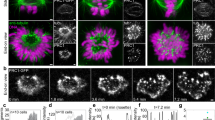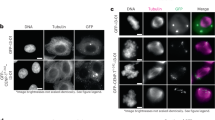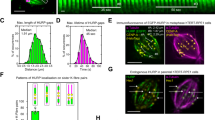Abstract
Intricate interactions between kinetochores and microtubules are essential for the proper distribution of chromosomes during mitosis. A crucial long-standing question is how vertebrate kinetochores generate chromosome motion while maintaining attachments to the dynamic plus ends of the multiple kinetochore MTs (kMTs) in a kinetochore fibre. Here, we demonstrate that individual kMTs in PtK1 cells are attached to the kinetochore outer plate by several fibres that either embed the microtubule plus-end tips in a radial mesh, or extend out from the outer plate to bind microtubule walls. The extended fibres also interact with the walls of nearby microtubules that are not part of the kinetochore fibre. These structural data, in combination with other recent reports, support a network model of kMT attachment wherein the fibrous network in the unbound outer plate, including the Hec1–Ndc80 complex, dissociates and rearranges to form kMT attachments.
This is a preview of subscription content, access via your institution
Access options
Subscribe to this journal
Receive 12 print issues and online access
$209.00 per year
only $17.42 per issue
Buy this article
- Purchase on Springer Link
- Instant access to full article PDF
Prices may be subject to local taxes which are calculated during checkout





Similar content being viewed by others
References
Tanaka, T. U., Stark, M. J. & Tanaka, K. Kinetochore capture and bi-orientation on the mitotic spindle. Nature Rev. Mol. Cell Biol. 6, 929–942 (2005).
Maiato, H., Deluca, J., Salmon, E. D. & Earnshaw, W. C. The dynamic kinetochore-microtubule interface. J. Cell Sci. 117, 5461–5477 (2004).
McIntosh, J. R., Grishchuk, E. L. & West, R. R. Chromosome-microtubule interactions during mitosis. Annu. Rev. Cell Dev. Biol. 18, 193–219 (2002).
Rieder, C. L. & Salmon, E. D. The vertebrate cell kinetochore and its roles during mitosis. Trends Cell Biol. 8, 310–318 (1998).
Desai, A. & Mitchison, T. J. Microtubule polymerization dynamics. Annu. Rev. Cell Dev. Biol. 13, 83–117 (1997).
Joglekar, A. P., Bouck, D. C., Molk, J. N., Bloom, K. S. & Salmon, E. D. Molecular architecture of a kinetochore-microtubule attachment site. Nature Cell Biol. 8, 581–585 (2006).
Cheeseman, I. M., Drubin, D. G. & Barnes, G. Simple centromere, complex kinetochore: linking spindle microtubules and centromeric DNA in budding yeast. J. Cell Biol. 157, 199–203 (2002).
De Wulf, P., McAinsh, A. D. & Sorger, P. K. Hierarchical assembly of the budding yeast kinetochore from multiple subcomplexes. Genes Dev. 17, 2902–2921 (2003).
Brinkley, B. R. & Stubblefield, E. The fine structure of the kinetochore of a mammalian cell in vitro. Chromosoma 19, 28–43 (1966).
McEwen, B. F., Heagle, A. B., Cassels, G. O., Buttle, K. F. & Rieder, C. L. Kinetochore fiber maturation in PtK1 cells and its implications for the mechanisms of chromosome congression and anaphase onset. J. Cell Biol. 137, 1567–1580 (1997).
McEwen, B. F. et al. CENP-E is essential for reliable bioriented spindle attachment, but chromosome alignment can be achieved via redundant mechanisms in mammalian cells. Mol. Biol. Cell 12, 2776–2789 (2001).
Cimini, D. et al. Merotelic kinetochore orientation is a major mechanism of aneuploidy in mitotic mammalian tissue cells. J. Cell Biol. 153, 517–527 (2001).
Zinkowski, R. P., Meyne, J. & Brinkley, B. R. The centromere-kinetochore complex: a repeat subunit model. J. Cell Biol. 113, 1091–1110 (1991).
VandenBeldt, K. J. et al. Kinetochores use a novel mechanism for coordinating the dynamics of individual microtubules. Curr. Biol. 16, 1217–1223 (2006).
Wei, R. R., Sorger, P. K. & Harrison, S. C. Molecular organization of the Ndc80 complex, an essential kinetochore component. Proc. Natl Acad. Sci. USA 102, 5363–5367 (2005).
Ciferri, C. et al. Architecture of the human ndc80-hec1 complex, a critical constituent of the outer kinetochore. J. Biol. Chem. 280, 29088–29095 (2005).
Cheeseman, I. M. et al. A conserved protein network controls assembly of the outer kinetochore and its ability to sustain tension. Genes Dev. 18, 2255–2268 (2004).
Cheeseman, I. M., Chappie, J. S., Wilson-Kubalek, E. M. & Desai, A. The conserved KMN network constitutes the core microtubule-binding site of the kinetochore. Cell 127, 983–997 (2006).
Emanuele, M. J., McCleland, M. L., Satinover, D. L. & Stukenberg, P. T. Measuring the stoichiometry and physical interactions between components elucidates the architecture of the vertebrate kinetochore. Mol. Biol. Cell 16, 4882–4892 (2005).
DeLuca, J. G. et al. Hec1 and nuf2 are core components of the kinetochore outer plate essential for organizing microtubule attachment sites. Mol. Biol. Cell 16, 519–531 (2005).
McEwen, B. F., Arena, J. T., Frank, J. & Rieder, C. L. Structure of the colcemid-treated PtK1 kinetochore outer plate as determined by high voltage electron microscopic tomography. J. Cell Biol. 120, 301–312 (1993).
McEwen, B. F., Hsieh, C. E., Mattheyses, A. L. & Rieder, C. L. A new look at kinetochore structure in vertebrate somatic cells using high-pressure freezing and freeze substitution. Chromosoma 107, 366–375 (1998).
Miranda, J. J., De Wulf, P., Sorger, P. K. & Harrison, S. C. The yeast DASH complex forms closed rings on microtubules. Nature Struct. Mol. Biol 12, 138–143 (2005).
Westermann, S. et al. Formation of a dynamic kinetochore- microtubule interface through assembly of the Dam1 ring complex. Mol. Cell 17, 277–290 (2005).
Rieder, C. L. The structure of the cold-stable kinetochore fiber in metaphase PtK1 cells. Chromosoma 84, 145–158 (1981).
Kapoor, T. M. et al. Chromosomes can congress to the metaphase plate before biorientation. Science 311, 388–391 (2006).
Cleveland, D. W., Mao, Y. & Sullivan, K. F. Centromeres and kinetochores: from epigenetics to mitotic checkpoint signaling. Cell 112, 407–421 (2003).
Okada, M. et al. The CENP–H-I complex is required for the efficient incorporation of newly synthesized CENP-A into centromeres. Nature Cell Biol. 8, 446–457 (2006).
Khodjakov, A., Cole, R. W., McEwen, B. F., Buttle, K. F. & Rieder, C. L. Chromosome fragments possessing only one kinetochore can congress to the spindle equator. J. Cell Biol. 136, 229–240 (1997).
Feng, J., Huang, H. & Yen, T. J. CENP-F is a novel microtubule-binding protein that is essential for kinetochore attachments and affects the duration of the mitotic checkpoint delay. Chromosoma 115, 320–329 (2006).
DeLuca, J. G. et al. Kinetochore microtubule dynamics and attachment stability are regulated by Hec1. Cell 127, 969–982 (2006).
McEwen, B. F., Marko, M., Hsieh, C. E. & Mannella, C. Use of frozen-hydrated axonemes to assess imaging parameters and resolution limits in cryoelectron tomography. J. Struct. Biol. 138, 47–57 (2002).
Acknowledgements
We thank R. Glaser, M. Koonce and T. Wagenknecht and for helpful comments on the manuscript. This work was supported by National Institutes of Health R01 GM06627 to B.F.M and GM59363 to A.K. We also acknowledge National Institutes of Health P41 RR01219 and National Science Foundation DBI9871347 to J. Frank to support the Wadsworth Center's Resource for Visualization of Biological Complexity and the FEI Tecnai F20 electron microscope. Finally, we are grateful for technical support from the Wadsworth Center's Core Facility for Electron Microscopy.
Author information
Authors and Affiliations
Contributions
B.F.M. directed the work. Y.D. and B.F.M. were responsible for experimental planning. K.J.V., Y.D. and B.F.M. preprared the specimens. K.J.V. and X.M. were responsible for data collection. Y.D. and K.J.V. computed tomographic reconstructions and Y.D. segemented the volumes. Y.D., B.F.M. and A.K. were responsible for data analysis and writing.
Corresponding author
Ethics declarations
Competing interests
The authors declare no competing financial interests.
Supplementary information
Supplementary Information
Supplementary Figure S1, S2, S3 and S4 (PDF 606 kb)
Supplementary Information
Supplementary Movie S1 (MOV 1577 kb)
Supplementary Information
Supplementary Movie S2 (MOV 3032 kb)
Supplementary Information
Supplementary Movie S3 (MOV 1218 kb)
Supplementary Information
Supplementary Movie S4 (MOV 3170 kb)
Supplementary Information
Supplementary Movie S5 (MOV 2566 kb)
Supplementary Information
Supplementary Movie S6 (MOV 3107 kb)
Rights and permissions
About this article
Cite this article
Dong, Y., Vanden Beldt, K., Meng, X. et al. The outer plate in vertebrate kinetochores is a flexible network with multiple microtubule interactions. Nat Cell Biol 9, 516–522 (2007). https://doi.org/10.1038/ncb1576
Received:
Accepted:
Published:
Issue Date:
DOI: https://doi.org/10.1038/ncb1576
This article is cited by
-
Dynamics of kinetochore structure and its regulations during mitotic progression
Cellular and Molecular Life Sciences (2020)
-
Overlap microtubules link sister k-fibres and balance the forces on bi-oriented kinetochores
Nature Communications (2016)
-
“Uno, nessuno e centomila”: the different faces of the budding yeast kinetochore
Chromosoma (2014)
-
Intrinsic microtubule GTP-cap dynamics in semi-confined systems: kinetochore–microtubule interface
Journal of Biological Physics (2013)
-
Regulatory mechanisms of kinetochore–microtubule interaction in mitosis
Cellular and Molecular Life Sciences (2013)



